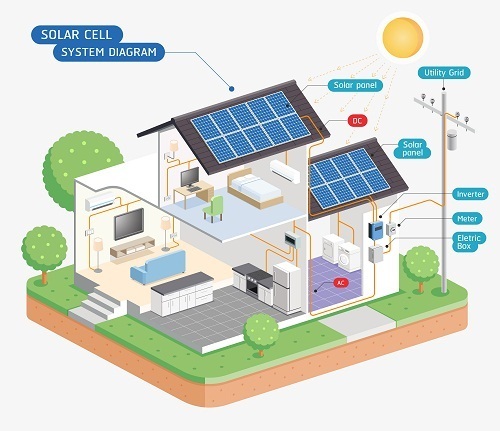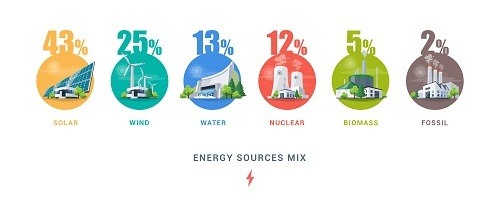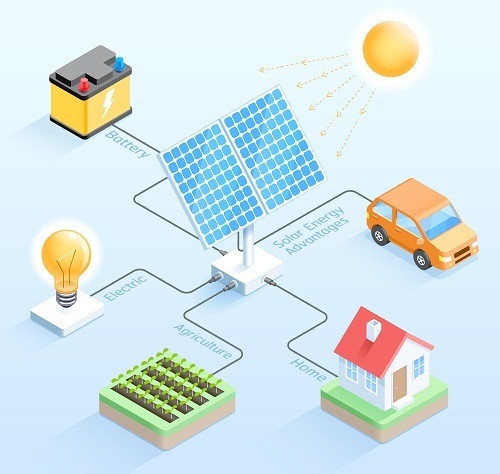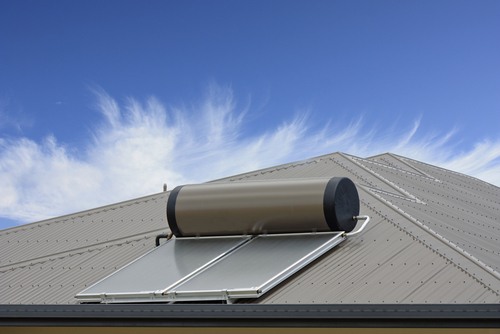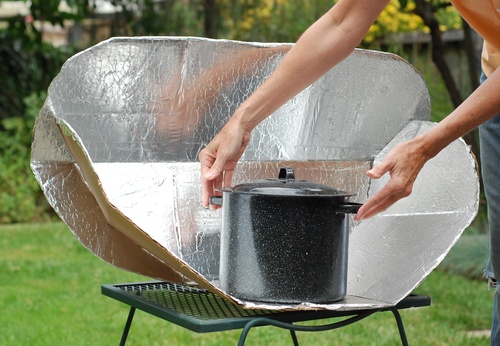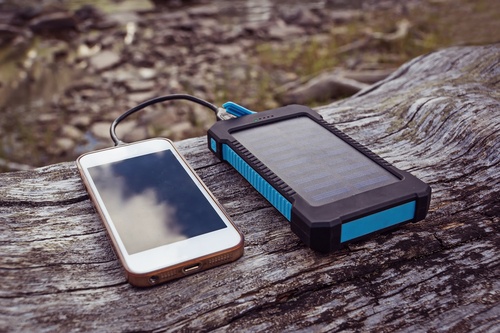Solar Energy Definitions: What Is Solar Energy?
Before we proceed further, let us step back and look at what the solar terms mean.
Solar means anything related to this sun. The sun is the star of the solar system and the first source of warmth and light on planet Earth.
Solar Energy is an energy that is harnessed directly from the sun's rays. It represents the capture of electromagnetic radiation from sunlight and its conversion to usable energy in the form of electricity or heat in more technical terms.
Solar thermal energy is heat rays from the sun, which is used to keep us warm, grow plants, and more recently, to heat water to our homes.
Solar power or solar electricity is power generated from solar energy. Solar panels we use on our houses do this via the photovoltaic effect, where radiation in sunlight is converted into electricity in a solar panel. This is how residential solar panels operate.
Solar power can also be made by concentrating the sunlight's energy to heat substances that could generate steam. This steam can then run a conventional turbine to produce power.
However, there are just a few of those concentrated solar thermal plants in 2020. Traditional solar panels using photovoltaic solar cells have become much cheaper and will be the dominant method to produce solar power.
Solar panels are a combination of solar cells that are wired together to increase energy production. There are generally 60 or 72 individual solar cells in every solar panel used on a House.
Amazing Solar Facts
In only two weeks, more energy from sunlight falls on the ground than the whole human population consumes in a year.
We could meet all the power needs of America by putting solar panels on just 11.2 million acres of land. With this perspective, that is only half a per cent of the total US landmass.
These facts create one thing clear: mind-blowing quantities of electricity can be generated from solar. Now let us take a deeper dive and find out more about solar energy, how it functions, and what it is suitable for.
Is Solar Energy Considered Renewable?
Solar energy is considered renewable because it doesn't deplete the finite resources of the planet. While the sunlight technically is a limited power supply, NASA quotes it's going to continue to produce solar power at its current rate for another 5 billion years.
Climate Change And The Significance Of Solar Energy
Humankind is facing a disaster of its own making.
Our lifestyles rely on access to electricity, heating, cooling, light, transportation, and several other things we believe essential. However, the way we've traditionally made our energy destroys our planet and puts the future of humanity in danger.
Traditional methods of energy production, like burning coal and gas, to create energy release greenhouse gases. The carbon greenhouse gases are heating our planet and changing our climate in ways that, if not right, will leave large sections of our world uninhabitable in an alarmingly short span.
This is extremely scary, and we will need to change the way we do energy quickly.
Another critical shortcoming of fossil fuel is they're non-renewable; if we keep using them the way we do today, they will eventually end.
The hunt for the best source of renewable energy
To reduce greenhouse gas emissions, we have to reduce fossil fuels for power generation and transportation. Collectively these applications have caused the bulk of greenhouse gas emissions.
Electric automobiles are emerging as the winner in the race to be the ideal technology for emissions-free transport.
This makes emissions-free electricity production extremely important as it can replace conventional transport emissions and traditional emissions from power generation.
This will require a worldwide movement to change our energy systems away from fossil fuels and replace them with clean (emissions-free) and renewable (renew naturally).
This is where solar and similar renewable energy resources have come in.
Solar power is the leading type of renewable and clean energy.
Consequently, there has been unprecedented investment in clean energy resources. Hydropower, wind power, and energy from biomass have attracted attention. However, the energy source contributing the international energy conversion is solar power.
Over the last decade (2010-2020), solar energy appeared as the single-biggest new electricity generation source, beating out every other fossil-fuel-based and clean energy resource. And solar will remain the dominant source of new clean energy for the near future.
According to the International Energy Agency, solar energy will account for 60 per cent of renewable energy growth through 2024.
What are the advantages of solar energy?
Solar power technology is utilized almost throughout the world for both off-grid and grid-connected applications. Solar power systems have many benefits over other non-renewable energy technologies and other renewable energy sources like wind energy.
Solar is the very best way to create electricity at home.
Energy is an integral part of our lives, and demand for it is continuously growing. At this time, most power is generated in large power plants using fossil fuels like natural gas.
Renewable energy sources such as solar are a growing but still small electricity source at the utility level.
It's a different story for electricity being generated on a smaller scale. In regards to onsite production at homes and companies, solar is almost always the best option. That is because solar electricity is affordable and straightforward to install.
For most homeowners, the electricity they can generate with solar panels proves to be much less expensive than the power they purchase from their utility company.
Other energy sources can make sense on a utility or even commercial scale but are just impractical or too costly to be set up at home.
Without going into too much detail, here are the deficiencies of the other energy resources on a residential scale:
The fuel for solar power is free.
You don't need to pay to use the sun. All you want is a rooftop or open area exposed to sunlight, and you will have access to a free source of everyday fuel for your solar energy system.
This is a significant advantage over generators and other fossil-fuel-powered power sources, where fuel is an ongoing and ever-changing cost.
Solar energy is available everywhere.
The sun shines all around the world. Even though some locations receive more sunlight than others, solar panel systems may create great power almost anywhere.
Get this: states with relatively dark, cold winters, such as Massachusetts, New Jersey, and New York, are among the top 10 states for solar. This is because of excellent pro-solar policies and how they can create and sell plenty of power in the summertime.
Solar panels last a long time.
Solar panels are very durable. It is pretty rare for you to stop working; they have a failure rate of just 0.05 percent annually. And they're designed to withstand extreme weather conditions such as hail and high-speed winds.
Most manufacturers provide a 25-year warranty on solar panel output. Although, experts believe that solar panels will produce electricity for 30-40 years.
It's easy to expand a solar energy system.
Solar panel systems are modular, meaning it is possible to add, subtract, or modify the system even after it has been installed. Plans can start small and increase as your energy demands increase or your budget allows.
Solar panels are quiet.
Solar power systems have no moving parts so that they do not make any sound when they produce electricity aside from a soft electrical hum.' And they're entirely silent at night, as no electricity is generated then.
No moving parts meaning no upkeep
There are no moving components on a solar energy system, meaning there is no regular maintenance required. This is a significant advantage that solar energy has over wind energy. Wind turbines need constant upkeep.
From sunlight to solar energy: How does solar energy work?
It almost seems like magic - using power from the sunlight all around us and turning it into a power source that can run appliances, HVACs, and electric cars. So how does this work?
Let's look at how sunlight becomes transformed into electricity that's usable for homes, businesses, and the electrical grid.
The Equipment required to produce solar power
Let's look at all the elements that go into a solar panel system.
A solar cell is an electrical device that includes a semiconductor material - generally silicon - which produces electricity when sunlight strikes it. The energy created by solar cells is direct current (DC) electricity.
A solar panel is a set of solar cells attached in a frame and covered in glass. There usually are 60-72 solar cells in every individual solar panel. Solar panels are also known as solar modules or photovoltaic (PV) panels.
A solar array is several solar panels wired together.
A solar panel system is your entire setup that offers usable solar electricity. It creates and transmits the power in a form that's ready for use, storage, or export to the grid. It could be composed of one or multiple arrays combined with accompanying tools such as mounting and wiring, racking, etc.
The Solar inverter is the central part of a solar system, following the solar panels. The inverter's job is to get the DC power generated by the solar array and turn it into AC power that could be used onsite or delivered to the grid.
How does solar energy work with the grid?
Solar power systems interact with the power grid differently depending on the scale of this undertaking.
Utility-Scale Solar Power And The Grid
Solar power plants (also called solar farms) are often owned by the utility or are constructed to sell their output to the utility. That implies the power only ever flows in one direction, i.e., from the solar power plant to the grid.
Home Solar Power And The Grid
Home solar power systems have a more complicated - but also more valuable - connection with the grid. Here, the power flow can work both ways; the house can sell power to the grid and purchase power from it when required.
This two-way, buy-sell relationship indicates a home with solar does not require a backup generation resource. When the sun is not shining, they could import electricity from the grid. Additionally, it suggests that expensive batteries are not required - if the panels produce an excessive amount of power, it can just be sold into the grid.
Beyond Solar Panels: Other Applications For Solar Energy
This stage in the blog has focused virtually exclusively on solar energy generated from photovoltaic solar panels. However, it is essential to be aware there are quite a few different ways solar energy can be used.
Here's a quick look at other significant solar power technologies.
Passive Solar Design (and solar heating and cooling)
The passive solar design utilizes the structural components to cool and heat it to decrease high-consumption gear like HVACs.
With the passive solar design, you will need to take into consideration the following factors to have a successful job:
Solar hot water (aka solar thermal)
Adding solar hot water or solar thermal system to a house can be relatively simple and of the very cost-effective ways to integrate renewable energy into your life.
A properly designed system works efficiently regardless of the outside temperature. If used together with a backup gas or electric heater, it provides ample hot water while reducing fossil fuel use by up to 80%.
Solar Cooking
Solar cooking is a useful renewable option and is one of the most straightforward examples of solar technologies. Solar ovens can be constructed from a wide assortment of materials capable of reaching 400 degrees Fahrenheit or longer.
Concentrating Solar Power (CSP) and Concentrating Photovoltaics (CPV)
Both the technologies are similar, as they use mirrors or special lenses to magnify/concentrate direct sun. Yet, there are a few significant differences among them.
Concentrating Photovoltaics (CPV) is solar electric technology. CPV turns amplified light into electricity with the solar cells.
Concentrating Solar Power (CSP) is a solar thermal technology (also referred to as heat-based or solar thermoelectricity) that utilizes magnified light to make heat. It runs on a steam turbine, which powers a generator, producing electricity.
Both Technologies Are Only Feasible On The Utility-Scale.
How can you use solar power in your life?
You'll have learned that solar energy is a flexible technology with many applications from reading this blog. This brings us to another question:
How Can You Apply The Advantages Of Solar Energy To Your Life?
There are many answers to this question. Gone are the days when the only solar-powered device on the market were handheld calculators and wristwatches! Solar panel technology improvements imply that solar energy can be made lighter, cheaper, and more powerful than ever before.
Here are some of the handiest and cost-effective applications of solar energy available now.
Solar-Powered Generators And Kits
If you're an avid hiker, camper, or outdoor enthusiast, you now have an enormous variety of solar choices. 100-watt solar panel kits are portable, simple to use, and excellent sources of power for RVs or people who like camping outside.
If you also want backup electricity, then consider solar-powered generators.
Solar-Powered Phone Chargers
Those who only want to keep their phone alive when they are on the go, check out our listing of the six finest solar phone chargers now available.
Solar-Powered Gifts
And if you're searching for fun devices to get a friend or loved one, check out our website on great solar-powered presents.
Solar power system for your house = highest savings
If you're a homeowner who wants to save money - and lowers your carbon footprint in the process - you should seriously think about getting rooftop solar panels.
Right now, is an excellent time to go solar. Due to immense price drops, solar panels are now more affordable than ever. And you will find generous government incentives, like the 26% federal tax credit, which are currently available (but scheduled to end soon).
In many states, now you can see savings of around $70,000-$100,000 within the duration of your solar panel system.
Importance Of The Solar Energy Sector In 2020
More than 2 million houses had solar panels installed by the end of 2019.
While the COVID-19 crisis has reduced solar installations, Q1 2020 struck a Q1 installation record (Q1 is traditionally a slow quarter) and connected with Q4 2019 as the biggest ever quarter for residential solar. This report gives a fantastic upgrade to the solar sector in Q2 2020 in the pandemic consequence.
The majority of solar energy generation is for utility-scale solar projects, which have numerous megawatts (a megawatt is 1,000 kW) of solar panels each.
Over 81.4 gigawatts (GW) of solar installed in the US, enough to power over 15.7 million houses.
The solar industry employs over 250,000 people in all 50 countries, making it among the nation's most crucial employment sources.
Overcoming The Drawbacks Of Solar Energy
The drawbacks of solar energy are mainly the cost to establish it and the fact it is an intermittent energy source. Those in the oil and coal industries who oppose solar use these things as a means to attack it?
However, the cost of solar in the utility-scale has dropped so much that it is now cheaper to add new solar power capacity than adding new coal and gas-fired power plants. Given this is currently true, opponents of solar may directly attack it on the premise it is intermittent (i.e., it doesn't operate at night and so by itself, it cannot be depended on as baseload power).
This is where energy storage alternatives come in. Utility-scale solar farms with energy storage may guarantee 24x7 power availability, such as gas or coal-fired power stations. The only catch is that now the energy storage cost could make this more costly as a baseload power option compared with coal or gas.
However, our planet can't survive with gas and coal power generation, so investments in reducing the expense of energy storage alternatives are crucial. It's essential that authorities globally to support energy storage for renewable energy generation.
Presently, solar energy storage costs about $0.19 per kWh, which relies on a Tesla Powerwall requiring $10,000 with the capability to store 14kWh of electricity and releasing it at a peak speed of 5kW per hour. So, energy storage that ensured 1 megawatt of baseload electricity would cost $2 million, or 200 Tesla Powerwall.
Add another $1.5 million to the PV generation, and you reach at $3.5 million per MW of stable baseload power with solar and battery storage using a 3-hour capacity at night.
This is more costly than the cost to construct a combined cycle coal-fired or gas power station (yet some reports claim coal does cost $3.5 million per MW). However, once the price of the gas and coal required overtime is considered, both are economically very similar concerning the Levelized cost per kW of their baseload electricity delivered.
The cost of battery storage only must drop another 50 per cent for solar and battery storage for a clear winner over gas or coal. An NREL battery energy storage cost projection study published in 2019 indicates that this will be the case before 2030.
Solar Training And How To Enter The Solar Industry
The solar industry is among the fastest-growing companies in our nation, and it poses many career opportunities for journeymen to fund executives.
There are great solar business training resources available both online and often at the local community college.
Standards for solar training are set by a body named NABCEP, the North American Board of Certified Energy Practitioners.
Individual training providers subsequently deliver courses intended to cover the required syllabus for solar salespeople and solar contractors.
The largest and best-known training provider is your non-profit Solar Energy International. They provide both paid and free courses online and at their training centre in Paonia, Colorado.
The great thing is that you may do their free course online.
The Future Of Solar
In the last decade, solar energy has raged in the US due to dropping prices and emerging technologies. Solar panels are now more efficient than ever while selling for the lowest prices. And the rates are predicted to get even lower later on.
The record-low costs of solar, along with the 26% federal tax credit, make 2020 the cheapest year to go solar yet. And even though the federal tax credit is set to expire at the end of 2021, Solar Energy Industries International (SEIA) still considers that over 5,000 megawatts of solar panels will be set up in 2023.
Plus, as the solar price continues to decrease, the Levelized Cost of electricity will fall as well. The price of solar energy is called to drop so low that fossil fuels won't have the ability to compete. As we focus on building clean energy infrastructure, we'll see a greener, cleaner, and more economical future!

